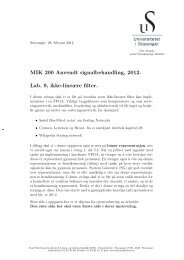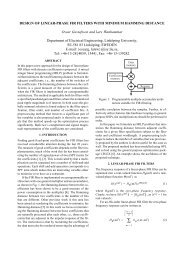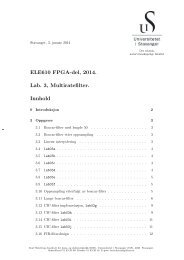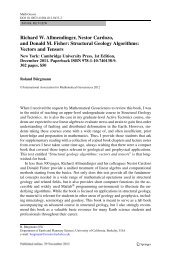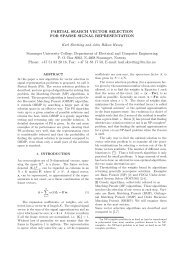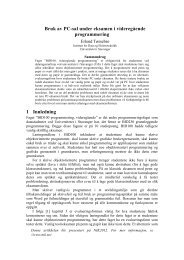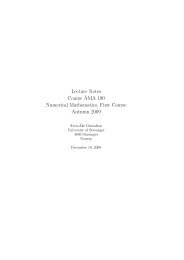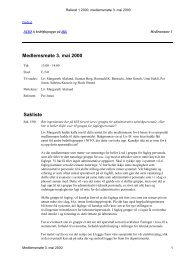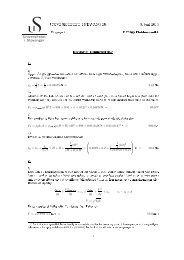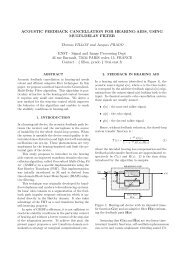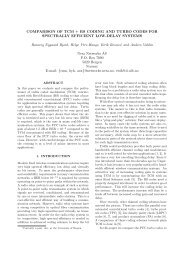MODELING OF LOW SALINITY EFFECTS IN SANDSTONE OIL ...
MODELING OF LOW SALINITY EFFECTS IN SANDSTONE OIL ...
MODELING OF LOW SALINITY EFFECTS IN SANDSTONE OIL ...
You also want an ePaper? Increase the reach of your titles
YUMPU automatically turns print PDFs into web optimized ePapers that Google loves.
10 OMEKEH, EVJE, AND FRIIScoefficient (longitudinal and transversal dispersion lengths are here taken to be equal), which issplit into molecular diffusion contribution and the so called mechanical/advective contribution. Awidely quoted formulation by Sahimi [32] is of the form(32)DD m= ϕ p s q + aP e + bP δ e + cP 2 e ,where D m is the free molecular diffusion coefficient, p, q, a, b, c, and δ are experimentally determinedconstants and P e is the Péclet number given by(33) P e = α|V|D m,where α is the characteristic dispersion length which varies from millimeters (in laboratory scale)to metres(field scale). Several authors [8, 32] have experimentally determined that the diffusionco-efficient is determined by only the first term of equation(32) when P e is less than 0.3, and atransition zone between 0.3 and 5 where D is not clearly defined. The other terms of the equationbecomes significant at higher Péclet numbers. For our application of the model, the Péclet numberfalls below 0.3, hence subsequently we use only the first term of equation (32). In (32) the coefficientp is referred to as the cementation exponent, q as the saturation exponent. The cementationexponent is often close to 2 whereas the saturation exponent is also often fixed at a value in thesame range, see for example [8, 10, 11]. Using (30) in (27) yields(34)∂ t (ϕs o C o ) + ∇ · (C o V o ) = 0,∂ t (ϕsC l ) + ∇ · (C l V l ) = 0,∂ t (ϕsC na ) + ∂ t (M c β na ) − ∇ · (D∇C na ) = −∇ · (C na V),∂ t (ϕsC cl ) − ∇ · (D∇C cl ) = −∇ · (C cl V),∂ t (ϕsC ca ) + ∂ t (M c β ca ) − ∇ · (D∇C ca ) = −∇ · (C ca V),∂ t (ϕsC so ) − ∇ · (D∇C so ) = −∇ · (C so V),∂ t (ϕsC mg ) + ∂ t (M c β mg ) − ∇ · (D∇C mg ) = −∇ · (C mg V).In particular, summing the equations corresponding to C na , C cl , C ca , C so , and C mg , we obtain anequation for C g in the form(35) ∂ t (ϕsC g ) + ∂ t (M c [β na + β ca + β mg ]) − ∇ · (D∇C g ) = −∇ · (C g V).In a similar manner, using C l V l = C l V − C g U g (obtained from (25), (26), and (24)) in the secondequation of (34), the following equation is obtained(36)∂ t (ϕsC l ) + ∇ · (C l V) = ∇ · (C g U g ).Summing (36) and (35), we get the following equation for the concentration of the water phasewith its different chemical components, represented by C = C g + C l ,(37) ∂ t (ϕsC) + ∂ t (M c [β na + β ca + β mg ]) + ∇ · (CV) = 0.To sum up, we have a model in the form(38)∂ t (ϕs o C o ) + ∇ · (C o V o ) = 0,∂ t (ϕsC) + ∂ t (M c [β na + β ca + β mg ]) + ∇ · (CV) = 0,where D = D(ϕ, s) as given by (32).∂ t (ϕsC na ) + ∂ t (M c β na ) + ∇ · (C na V) = ∇ · (D∇C na ),∂ t (ϕsC cl ) + ∇ · (C cl V) = ∇ · (D∇C cl ),∂ t (ϕsC ca ) + ∂ t (M c β ca ) + ∇ · (C ca V) = ∇ · (D∇C ca ),∂ t (ϕsC so ) + ∇ · (C so V) = ∇ · (D∇C so ),∂ t (ϕsC mg ) + ∂ t (M c β mg ) + ∇ · (C mg V) = ∇ · (D∇C mg ),



